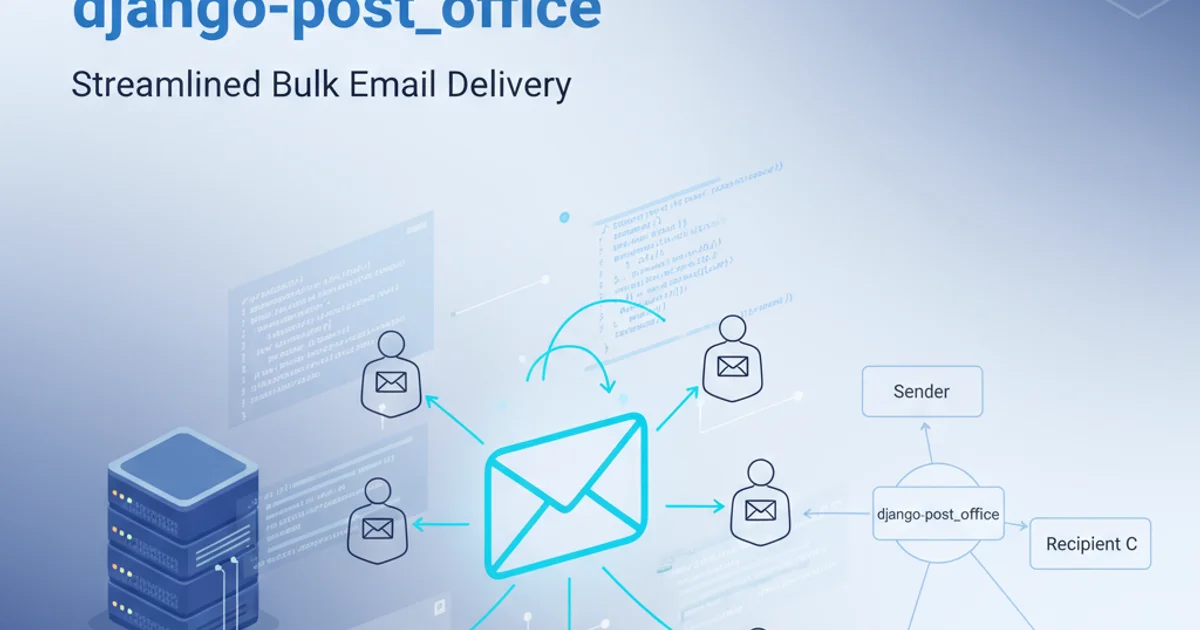Send email once to multiple recipients using django-post_office
Categories:
Efficient Email Delivery: Sending to Multiple Recipients with django-post_office

Learn how to leverage django-post_office to send a single email to multiple recipients efficiently, avoiding duplicate sends and optimizing your Django application's email workflow.
Sending emails is a common requirement for many web applications, from user notifications to marketing campaigns. In Django, django-post_office is a popular choice for handling asynchronous email sending, retries, and templating. A frequent challenge arises when you need to send the same email content to multiple distinct recipients. Simply looping through recipients and calling send_mail for each can be inefficient and lead to unnecessary database entries or API calls if not handled correctly. This article will guide you through the best practices for sending a single email to multiple recipients using django-post_office, ensuring efficiency and proper delivery.
Understanding django-post_office Basics
django-post_office works by queuing emails in your database and sending them in the background using a management command. This decouples email sending from your request-response cycle, improving application performance. When sending an email, you typically use the send_mail function, which takes parameters like subject, message, from_email, and recipient_list.
from post_office import mail
def send_single_email_example():
mail.send_mail(
'Welcome to Our Service!',
'Thank you for signing up. We are excited to have you!',
'noreply@example.com',
['user1@example.com'],
priority='now' # Or 'medium', 'low'
)
print("Email queued for user1@example.com")
Basic usage of mail.send_mail for a single recipient.
Sending to Multiple Recipients: The recipient_list Parameter
The send_mail function in django-post_office (and Django's built-in send_mail) is designed to accept a list of email addresses for the recipient_list parameter. When you provide multiple addresses in this list, django-post_office intelligently handles the queuing process. It creates a single Email object in the database but associates it with multiple EmailRecipient objects, one for each address in the recipient_list. This is the most efficient way to send the same email content to many people.
flowchart TD
A[Application Calls mail.send_mail] --> B{"recipient_list contains multiple emails?"}
B -->|Yes| C[Create single Email object in DB]
C --> D[Create multiple EmailRecipient objects in DB]
D --> E[Associate Email with all EmailRecipients]
E --> F[Background Worker Sends Email]
F --> G[Each recipient receives a copy]
B -->|No| H[Create single Email object in DB]
H --> I[Create single EmailRecipient object in DB]
I --> J[Associate Email with EmailRecipient]
J --> FWorkflow for sending emails with django-post_office to single vs. multiple recipients.
from post_office import mail
def send_to_multiple_recipients():
recipients = [
'alice@example.com',
'bob@example.com',
'charlie@example.com'
]
mail.send_mail(
'Important Announcement!',
'Dear valued customer, we have an important update for you.',
'updates@example.com',
recipients,
priority='medium',
html_message='<p>Dear valued customer, we have an <b>important update</b> for you.</p>'
)
print(f"Email queued for {len(recipients)} recipients.")
Sending a single email to a list of recipients using django-post_office.
django-post_office is designed for scalability. Also, ensure your email server can handle the volume.Using Templates for Personalized Bulk Emails
django-post_office excels at using templates, which can be particularly powerful when sending to multiple recipients. While the core message remains the same, you might want to personalize aspects like the recipient's name. For this, you would typically use render_on_delivery=True and pass a dictionary of context variables. However, if each recipient needs different personalization, you would need to send individual emails or use a more advanced templating system that can iterate over recipients within a single template (which django-post_office doesn't directly support for recipient_list context). For simple, identical content to multiple recipients, the recipient_list approach is best. For highly personalized content, individual send_mail calls with specific context per user might be necessary, or using a dedicated email service provider's bulk send features.
from post_office import mail
def send_templated_email_to_multiple():
# Assuming you have an EmailTemplate named 'announcement_template'
# with content like: 'Hello {{ name }}, here is your update.'
# For identical content, no special context needed per recipient
recipients = [
'eve@example.com',
'frank@example.com'
]
mail.send_mail(
'Your Latest Update',
'', # Message can be empty if using template
'info@example.com',
recipients,
template='announcement_template',
context={'company_name': 'Acme Corp'},
priority='now'
)
print(f"Templated email queued for {len(recipients)} recipients.")
Sending a templated email to multiple recipients with shared context.
recipient_list and call mail.send_mail for each individual recipient if the email content is identical. This will create redundant Email objects in your database and is less efficient than passing the full list to a single send_mail call.By utilizing the recipient_list parameter correctly, django-post_office provides an elegant and efficient solution for sending the same email to multiple recipients. This approach minimizes database overhead and streamlines your email sending process, making your Django application more performant and easier to manage.